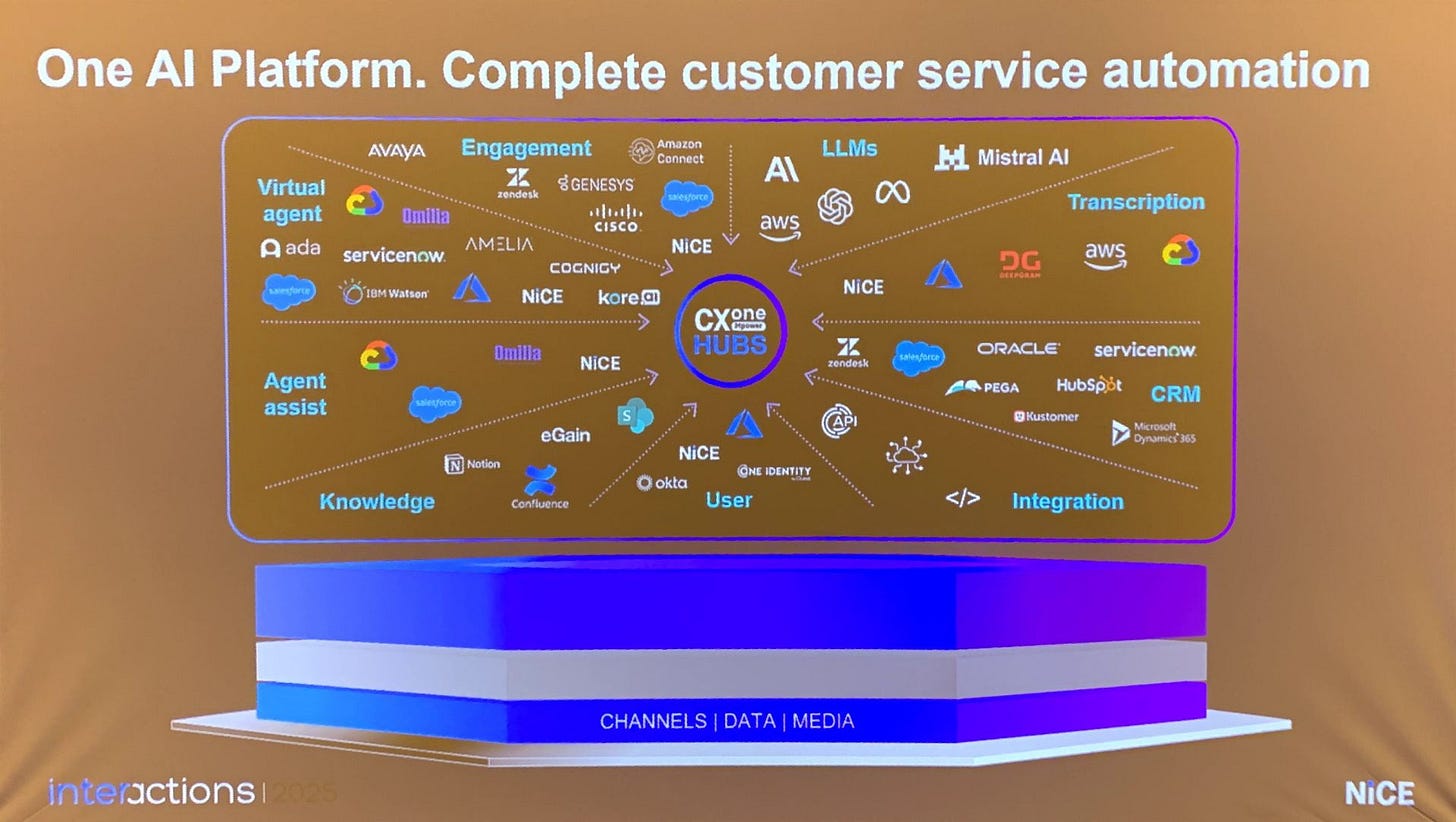Last week, I attended my first NiCE Interactions in Las Vegas. Though I’ve followed NiCE and inContact since their early days, the event was full of new learnings.
The event impressed with 3,000 attendees and a highly engaged user community. Six marquee customers—Walmart, Disney, Carnival UK, H&R Block, ALG, and Charles Schwab—took the keynote stage. Most tellingly: 69 of the 81 sessions were led by customers.
It was also the first Interactions under Scott Russell, who took the helm earlier this year and set the tone with great energy. Scott outlined his bold ambition: to transform NiCE from a CCaaS vendor into a CX AI company that manages interactions and orchestrates the fulfillment behind them. This means moving beyond the front office to unify mid- and back-office execution.
Delivering on this ambition requires a platform that goes beyond traditional CCaaS and is embodied in the shift from CXone to CXone Mpower, anchored in three pillars: Workflows, Agents, and Knowledge.
NiCE has long positioned CXone as an all-in-one solution. At Interactions, I saw firsthand how effectively that message has landed, especially with industries historically slower to adopt CX technology. By showcasing the art of the possible, NiCE has driven deep adoption and gained meaningful share in several verticals.
With its expanded CX AI vision, NiCE is now bringing its platform to the forefront. Barry Cooper closed his product keynote with a clear two-pronged call to action: implement the platform and start unlocking its AI potential.
This next phase also puts greater emphasis on third-party integrations, critical for industries that favor best-of-breed solutions or must evolve their complex stacks one layer at a time.
To support this shift, NiCE is expanding its Hubs, defining how third-party applications can be integrated with CXone Mpower. Each hub provides APIs and other mechanisms that go beyond simple interworking to embed integrations into the platform. CXone Mpower has nearly doubled its supported hubs, now spanning Engagement (third-party interaction channels), Virtual Agents, AI models, Transcription services, CRM, Knowledge federation, User (SSO), Agent Assist (external assistants and copilots), and Voice Biometrics.
At the event, NiCE launched CXone Mpower Agents, designed to drive automation across conversations and fulfillment workflows. It also introduced CXone Mpower Desk, built specifically for back-office needs. Leveraging Livevox technology, Mpower Desk features both a contact management system and a ticketing system.
David Gustafson and Larry Skowronek provided a detailed walkthrough of NiCE’s platform. Built on Snowflake, its data lake unifies customer interactions and includes rich agent data—schedules, evaluations, coaching sessions, and more. NiCE has unified its interaction model across voice and digital channels and enhanced the agent model to support multitasking across simultaneous activities and interactions. The data lake integrates bidirectionally with third-party data, a central element of NiCE’s recent strategic partnerships with AWS and Snowflake.
NiCE’s platform includes sovereign cloud options in multiple countries, which has been a key factor behind its recent major government wins in Europe and Australia.
AI applications and agents are built in Studio, leveraging a broad spectrum of commercial and proprietary models, including GenAI, topic classification, behavioral, and predictive. Native to the platform, these AI capabilities power every application in the CXone Mpower suite. CXone Mpower Agents can be deployed inside Copilot to automate agent tasks, in AutoPilot to enhance self-service, as Proactive AI Agents, or within workflows orchestrated via Orchestrator.
Elizabeth Tobey unpacked two powerful components of the suite for me: Enlighten Actions and Orchestrator. Announced last year, Enlighten Actions mines interaction data to surface actionable CX improvements. Unveiled more recently at Enterprise Connect, Orchestrator takes the concept further: it uses AI to extract workflows from interaction records, leveraging evaluations and screen recordings to gain visibility into the fulfillment of customer interactions. While customer service is highly process-driven, many processes aren’t formally documented, making Orchestrator’s discovery capabilities particularly compelling. It then identifies workflow tasks ripe for automation by agents.
NiCE is shifting from a channel-centric approach to putting partners at the core of its growth strategy, a significant evolution. It’s actively building alliances with CRM vendors and hyperscalers and has already announced strategic relationships with AWS, ServiceNow, and Snowflake. Each partnership features deeper integration and a joint blueprint that delineates responsibilities across platforms while allowing flexibility for some overlapping components.
Partners already play a major role in NiCE’s go-to-market: 75% of last year’s wins involved at least one partner, and 63% of CXone Mpower's new ACV came through them. Scott Russell and Dan Belanger delivered a strong message: NiCE is committed to putting partners at the center of its go-to-market moving forward.
With urgency and energy, Scott has set the stage for NiCE’s Act IV: transform it into an AI platform that powers both interactions and their fulfillment across front and back offices, lead with the platform, and accelerate growth through partners.






